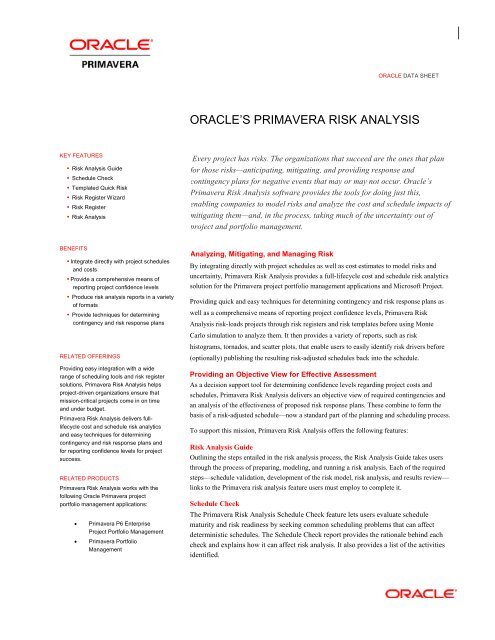Primavera Risk Analysis (PDF) - Oracle
Primavera Risk Analysis (PDF) - Oracle
Primavera Risk Analysis (PDF) - Oracle
Create successful ePaper yourself
Turn your PDF publications into a flip-book with our unique Google optimized e-Paper software.
ORACLE DATA SHEETORACLE’S PRIMAVERA RISK ANALYSISKEY FEATURES• <strong>Risk</strong> <strong>Analysis</strong> Guide• Schedule Check• Templated Quick <strong>Risk</strong>• <strong>Risk</strong> Register Wizard• <strong>Risk</strong> Register• <strong>Risk</strong> <strong>Analysis</strong>Every project has risks. The organizations that succeed are the ones that planfor those risks—anticipating, mitigating, and providing response andcontingency plans for negative events that may or may not occur. <strong>Oracle</strong>’s<strong>Primavera</strong> <strong>Risk</strong> <strong>Analysis</strong> software provides the tools for doing just this,enabling companies to model risks and analyze the cost and schedule impacts ofmitigating them—and, in the process, taking much of the uncertainty out ofproject and portfolio management.BENEFITS• Integrate directly with project schedulesand costs• Provide a comprehensive means ofreporting project confidence levels• Produce risk analysis reports in a varietyof formats• Provide techniques for determiningcontingency and risk response plansRELATED OFFERINGSProviding easy integration with a widerange of scheduling tools and risk registersolutions, <strong>Primavera</strong> <strong>Risk</strong> <strong>Analysis</strong> helpsproject-driven organizations ensure thatmission-critical projects come in on timeand under budget.<strong>Primavera</strong> <strong>Risk</strong> <strong>Analysis</strong> delivers fulllifecyclecost and schedule risk analyticsand easy techniques for determiningcontingency and risk response plans andfor reporting confidence levels for projectsuccess.RELATED PRODUCTS<strong>Primavera</strong> <strong>Risk</strong> <strong>Analysis</strong> works with thefollowing <strong>Oracle</strong> <strong>Primavera</strong> projectportfolio management applications:• <strong>Primavera</strong> P6 EnterpriseProject Portfolio Management• <strong>Primavera</strong> PortfolioManagementAnalyzing, Mitigating, and Managing <strong>Risk</strong>By integrating directly with project schedules as well as cost estimates to model risks anduncertainty, <strong>Primavera</strong> <strong>Risk</strong> <strong>Analysis</strong> provides a full-lifecycle cost and schedule risk analyticssolution for the <strong>Primavera</strong> project portfolio management applications and Microsoft Project.Providing quick and easy techniques for determining contingency and risk response plans aswell as a comprehensive means of reporting project confidence levels, <strong>Primavera</strong> <strong>Risk</strong><strong>Analysis</strong> risk-loads projects through risk registers and risk templates before using MonteCarlo simulation to analyze them. It then provides a variety of reports, such as riskhistograms, tornados, and scatter plots, that enable users to easily identify risk drivers before(optionally) publishing the resulting risk-adjusted schedules back into the schedule.Providing an Objective View for Effective AssessmentAs a decision support tool for determining confidence levels regarding project costs andschedules, <strong>Primavera</strong> <strong>Risk</strong> <strong>Analysis</strong> delivers an objective view of required contingencies andan analysis of the effectiveness of proposed risk response plans. These combine to form thebasis of a risk-adjusted schedule—now a standard part of the planning and scheduling process.To support this mission, <strong>Primavera</strong> <strong>Risk</strong> <strong>Analysis</strong> offers the following features:<strong>Risk</strong> <strong>Analysis</strong> GuideOutlining the steps entailed in the risk analysis process, the <strong>Risk</strong> <strong>Analysis</strong> Guide takes usersthrough the process of preparing, modeling, and running a risk analysis. Each of the requiredsteps—schedule validation, development of the risk model, risk analysis, and results review—links to the <strong>Primavera</strong> risk analysis feature users must employ to complete it.Schedule CheckThe <strong>Primavera</strong> <strong>Risk</strong> <strong>Analysis</strong> Schedule Check feature lets users evaluate schedulematurity and risk readiness by seeking common scheduling problems that can affectdeterministic schedules. The Schedule Check report provides the rationale behind eachcheck and explains how it can affect risk analysis. It also provides a list of the activitiesidentified.
ORACLE DATA SHEETTemplated Quick <strong>Risk</strong>The <strong>Primavera</strong> <strong>Risk</strong> <strong>Analysis</strong> Templated Quick <strong>Risk</strong> feature uses a template approach toassign uncertainty risk distributions to tasks based on WBS (work breakdown structure),activity code, user-defined field, or filter. Providing a more advanced way of executingquick risk, these templates make it easy to model task uncertainty.<strong>Risk</strong> Register WizardWith the <strong>Primavera</strong> <strong>Risk</strong> <strong>Analysis</strong> <strong>Risk</strong> Register Wizard, users can quickly create newrisk registers, defining risk scoring criteria, entering qualitative risk assessments, andmapping risks to scheduled activities. Users can then gather quantitative assessments andmore-detailed information in the resulting risk registers.<strong>Risk</strong> RegisterBy using the <strong>Risk</strong> Register feature in <strong>Primavera</strong> <strong>Risk</strong> <strong>Analysis</strong>, users can integratepredeveloped risk registers as well as define new ones (see Figure 1). Users can alsoemploy this feature to produce both qualitative and quantitative models of positive andnegative risk events (threats and opportunities) and their associated response plans (suchas mitigation). <strong>Risk</strong> Register also automatically integrates identified risk events into theschedule, by creating a risk event plan, which users can then analyze to determine bothkey risk drivers and the cost-effectiveness of the identified mitigation strategies.Figure 1: <strong>Primavera</strong> <strong>Risk</strong> Register<strong>Risk</strong> <strong>Analysis</strong><strong>Primavera</strong> <strong>Risk</strong> <strong>Analysis</strong> uses advanced Monte Carlo-based cost and schedule analyticsto provide full-lifecycle risk management through the following types of risk models:estimate uncertainty, task existence, probabilistic branching, fixed-cost uncertainty,variable-cost uncertainty, resource uncertainty, conditional branching, and weathermodeling. In addition, users can conduct risk analyses at both the project and portfoliolevel, making strategic decisions about project selection through portfolio models as wellas traditional project-level risk analysis against individual or linked schedules.Flexible ReportingWith <strong>Primavera</strong> <strong>Risk</strong> <strong>Analysis</strong>, users can view risk assessments in a variety of formats:2
ORACLE DATA SHEETDistribution GraphBy using <strong>Primavera</strong> <strong>Risk</strong> <strong>Analysis</strong> distribution graphs (see Figure 2), users can• Determine confidence levels, P schedules, and schedule and cost contingency• Report confidence levels with regard to finish dates, costs, float, internal rateof return, and net present value• Drill down through the interactive report to identify confidence levels atmultiple levels, including key milestones and stage-gate review points• Tab between cost- and schedule-based views with the ability to drill downthrough the integrated tree control and filter by task or resourceFigure 2: Distribution graphTornado Graph<strong>Primavera</strong> <strong>Risk</strong> <strong>Analysis</strong> tornado graphs help users identify key risk drivers and pinpoint thetask or risk event that’s preventing their schedules from performing as expected.Alternatively, users can employ cost-sensitivity reports to isolate the most-cost-criticaltasks or risk events. Interactive drill-down risk tornados enable quick and easy risk driverdetermination to report on key risk drivers.3
ORACLE DATA SHEETFigure 3: Tornado graphScatter PlotUsers can use this type of report to determine the combined probability of achievinggiven budgets and completion dates as well as to perform what-if analyses (byinteractively varying cost and schedule thresholds to reveal the resulting chances ofsuccess).Figure 4: Scatter plotDistribution Analyzer4
ORACLE DATA SHEETUsers can employ this type of report (see Figure 3) to• Compare scenarios and determine the cost/benefit ratio of mitigation plans• Overlay an unlimited number of cost or schedule risk distribution reports• Send risk distributions directly from the risk histogram view to the distributionanalyzer report for risk scenario comparison and analysis• Take advantage of standard and advanced cost modes for quick and easymodeling of costs and resources while retaining optional advanced featuresFigure 5: Distribution analyzerProbabilistic Cash FlowA probabilistic cash flow report (shown in Figure 4) is critical for forecasting, long-termbudgeting, and earned-value management systems (EVMS) reporting. In addition toproviding reporting and overlay options such as percentile date shading, <strong>Primavera</strong> <strong>Risk</strong><strong>Analysis</strong> can filter the probabilistic cash flow based on specific resources and costclasses within the project plan. In addition, cash flows can be generated for specificresource and cost types.5
ORACLE DATA SHEETFigure 6: Probabilistic cash flowSummary <strong>Risk</strong> Report<strong>Primavera</strong> <strong>Risk</strong> <strong>Analysis</strong> lets users quickly share the results of their risk analyses via summaryrisk reports. Users simply select the activities, risk inputs, and risk outputs, and <strong>Primavera</strong><strong>Risk</strong> <strong>Analysis</strong> creates an interactive report that includes the links between inputs and outputsin the report and the activities in the schedule.ConclusionProviding easy integration with a wide range of scheduling tools and risk register solutions,<strong>Primavera</strong> <strong>Risk</strong> <strong>Analysis</strong> helps project-driven organizations ensure that mission-criticalprojects come in on time and under budget. Delivering full-lifecycle cost and schedule riskanalytics, <strong>Primavera</strong> <strong>Risk</strong> <strong>Analysis</strong> offers easy techniques for determining contingency andrisk response plans and for reporting confidence levels for project success.Contact UsFor more information about <strong>Oracle</strong>’s <strong>Primavera</strong> <strong>Risk</strong> <strong>Analysis</strong> or any <strong>Oracle</strong> <strong>Primavera</strong> products, please visit www.oracle.com/primavera or call1.800.423.0245 to speak to an <strong>Oracle</strong> <strong>Primavera</strong> representative.Copyright © 2013, <strong>Oracle</strong> and/or its affiliates. All rights reserved.This document is provided for information purposes only, and the contents hereof are subject to change without notice. This document is not warranted to be error-free, nor subjectto any other warranties or conditions, whether expressed orally or implied in law, including implied warranties and conditions of merchantability or fitness for a particular purpose.We specifically disclaim any liability with respect to this document, and no contractual obligations are formed either directly or indirectly by this document. This document may notbe reproduced or transmitted in any form or by any means, electronic or mechanical, for any purpose, without our prior written permission.<strong>Oracle</strong> and Java are registered trademarks of <strong>Oracle</strong> and/or its affiliates. Other names may be trademarks of their respective owners.Intel and Intel Xeon are trademarks or registered trademarks of Intel Corporation. All SPARC trademarks are used under license and are trademarks or registered trademarks ofSPARC International, Inc. AMD, Opteron, the AMD logo, and the AMD Opteron logo are trademarks or registered trademarks of Advanced Micro Devices. UNIX is a registeredtrademark of The Open Group. 01136




